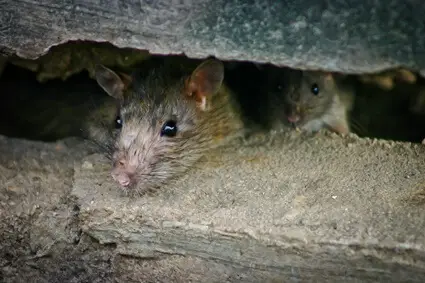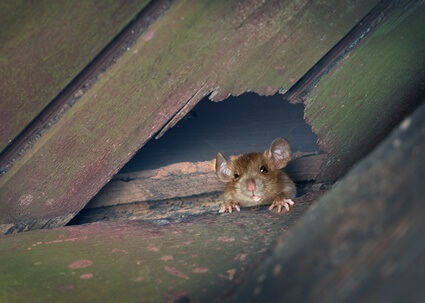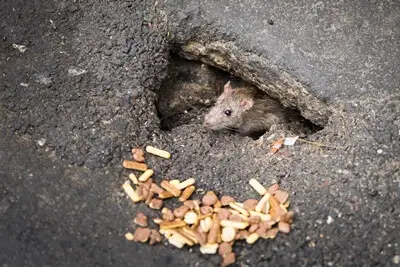Rats are cunning pests that know where to seek refuge in your home. They know when to scavenge for food and when to stay out of sight.
This opportunistic behavior makes it hard to keep them away from our homes. Their impressive flexibility, which allows them to get through small spaces, makes it even harder.
Rats have flexible bodies that can squeeze through the tiniest of holes. Despite having skeletons, their ribs can flex more than other mammals, allowing them to squeeze through narrow openings.
Their cylindrical shape also increases their flexibility, allowing them to pass through tight spaces. Rats don’t have a collarbone, making it easier for them to fit wherever their heads can pass through.
Any unsealed holes or cracks on your walls, basement, or crawl space serve as a leeway for rats to find their way into your home.
How Can Rats Get Through Small Holes?
Rats can get through tiny holes because of their impressive flexibility.
Their skill in squeezing through tiny openings makes many people believe that rats don’t have bones. However, that’s a myth. Rats are mammals, meaning they have a skeletal system.
Even though rats have a skeleton that includes a spinal cord and rib cage, they have a greater capacity to flex their bones than other mammals. For this reason, they can pass through tiny cracks easily.
Rats are long and have cylindrical bodies, allowing them to squeeze through holes seamlessly. They also have sharp teeth and strong legs that help them gnaw and burrow through tiny holes.
Since rats lack a collarbone, there’s little chance of getting stuck when passing through these openings.
Can Rats Squeeze Through Cracks?
Rats can squeeze through cracks. However, it depends on the size of the crack. If the rat’s head cannot fit the opening, it’ll search for an alternative route.
Rats usually have small bodies measuring 5 inches long. Besides, they have sharp teeth and strong jaws that can gnaw through soft materials like wood, plastic, and cardboard.
Their forelegs are strong enough to burrow and widen existing cracks and openings. With this in mind, squeezing through holes shouldn’t be a problem.
The ability to squeeze through cracks and tiny holes is a natural survival mechanism. If you look at a rat up close, you will notice that it has a long body with a cylindrical shape.
Rats have narrow shoulders and pointed heads, and this body type makes it easy for them to squeeze through small gaps and tiny openings.
Sometimes, rats can convert the cracks and holes in your walls into nests and hiding spots. Sealing these holes is an excellent way to prevent more rats from entering your home.

How Small Of An Opening Can A Rat Fit Through?
A small rat can fit through a 0.705-inch hole without much problem. Due to their flexibility and body shape, they can squeeze through openings smaller than a dime.
Before a rat tries to pass through a hole, it must test whether it can fit through it. The ability to judge the size of a crack comes in handy during times of danger.
According to the Institute of Behavioral and Neural Sciences, a rat uses its whiskers to determine whether the opening is large enough to fit through.
The rat pokes its pointed head into the hole to calculate its size. If the space is small, the rat will try an alternative. Sometimes, the rat may use its strong forelegs to increase the size of the crack so that it can fit through. It may also gnaw through the hole using its sharp teeth.
Large and overweight rats may have challenges fitting through tiny openings. With excess fat accumulating around their abdomens, obese rats have large girths.
Can A Rat Fit Through A Pencil Hole?
Even though rats are agile animals, they cannot fit through a pencil hole. However, small baby rats can fit through a pencil hole if the diameter of the gap is 6-7mm.
Nevertheless, this isn’t practical and shouldn’t be a concern. Baby rats rarely leave their nests and don’t start walking until they’re about 2 weeks old.
The minimum diameter a healthy adult rat can pass through is about 20mm. If you have cracks or small openings in your home with this width, do not hesitate to seal them immediately to prevent a rat infestation.
Can A Rat Fit Through Chicken Wire?
Rats can fit through chicken wires without much problem. Chicken wire can only prevent large predators from gaining access, not small predators like rats and snakes.
The holes between the wires are 1 to 2 inches wide, large enough for rats to squeeze through. Moreover, rats have sharp teeth they can use to gnaw their way through most materials, including chicken wire.
Use galvanized steel to keep rats away from your chicken coop.
Can Rats Get Through Small Holes?
Rats can easily pass through small holes. You may have a rat problem in your home, even if there are no noticeable gaps or spaces where they can pass through.
Rats are agile and flexible, allowing them to pass through tight spaces. They can squeeze through tiny holes by flexing their muscles and stretching their bodies.
Their long, cylindrical bodies increase their flexibility. Since they have narrow shoulders and no collarbone, fitting through small holes isn’t an issue.
How Do Rats Fit Through Small Cracks?
Rats fit through small cracks due to their long, cylindrical bodies.
They use their pointed heads to measure the diameter of the crack before attempting to pass through. If the rat’s head fits the space, it can easily squeeze through the crack.
If the hole is too small and the rat has no alternative route, it will try to widen it by digging or gnawing through the material. Rats have strong forelegs, which they use to burrow.
According to Observations on the History and Habitat, they can even burrow under concrete slabs.

Can A Rat Fit Under A Door?
Rats may or may not fit under a door. It all depends on the gap at the bottom of the door and the size of the rat. The floor type may also determine whether a rat can slide under a door.
The average exterior door shouldn’t have space between the sill and the floor.
Contractors rarely leave spaces beneath exterior doors to prevent wind, dust, and other harsh elements from passing through. With no gap at the bottom, rats and other large pests may not fit under the door.
However, this is not the same for interior doors. The gap between the door sill and a finished floor should be ½ or ¾ of an inch.
This space might seem tiny, but it’s large enough for a rat to squeeze through. To deter rats, consider fitting strips to the bottom of your doorways.
Do Rats Have Bones?
Many people assume that rats don’t have bones due to their flexibility. Other myths claim that rats have a skeleton, but their bones are collapsible.
Contrary to myths and assumptions, rats do have bones. Their skeletal system consists of a rib cage and a spinal cord, which isn’t collapsible.
The only difference between rats and other mammals is that they can wriggle through tight spaces due to their long, cylindrical bodies.
Rats have narrow shoulders and no collarbone, allowing them to squeeze through small holes.
How Small A Hole Can A Rat Get Through?
A rat can squeeze through a hole the size of a dime (about 0.705 inches). However, this depends on the size of the rat. A healthy adult rat might get stuck trying to pass through such a small hole.
The reason why rats can get through such small spaces has to do with their agility and flexibility. They have long, cylindrical bodies that make it easy for them to squeeze through tiny openings.







